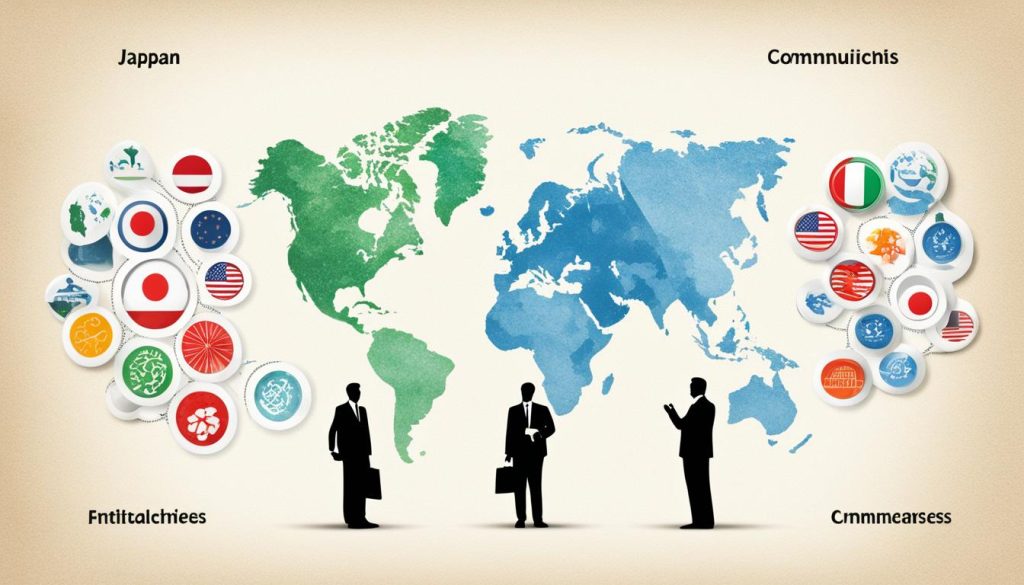Understanding how cross-cultural management works is key for global businesses. We’ll look at corporate culture differences in Japan, Italy, and the USA. Through this, we’ll explore their unique leadership styles, decision-making, and hierarchy. Our goal is to highlight the international business practices that are essential for success in these countries.
The Japan USA Italy business comparison provides deep insights. It shows how each country’s history, society, and traditions impact corporate behaviour. As companies go global, understanding these corporate culture differences is crucial. It helps in achieving international success and fostering productive international relationships.
Introduction to Cultural Dynamics in Business
Success in international trade deeply relies on understanding cultural dynamics. This knowledge prevents misunderstandings in managing global teams. Erin Meyer has shown how differences in leadership culture impact worldwide organisations. Every meeting, whether face-to-face or online, carries potential cultural paradoxes. These can affect team work and unity.
Global business involves various practices in authority, discussions, and making choices. For example, what seems like direct supervision in one culture may look like micromanagement in another. A consultative stance might appear indecisive in different cultures. These examples show why it’s vital to value and adapt to varied leadership cultures.
To handle cultural differences better, managers can employ several strategies. They include:
- Encourage open talk about cultural expectations among team members.
- Offer training that highlights recognizing and respecting cultural differences in business.
- Create flexible management plans that match different cultural settings within the team.
In today’s world, global businesses are like connected hubs, not single units. Being skilled in managing cross-cultural dynamics is crucial. It helps businesses succeed globally. Meyer’s advice guides companies through the challenges of modern leadership cultures. It also teaches them to honour their teams’ diverse backgrounds.
Historical Overview of Business Practices in Japan, Italy, and the USA
Understanding the historical business evolution helps us see what makes business cultures unique in Japan, Italy, and the USA. Each country’s business heritage has shaped its current business world. They each have their own ways that stand out in their economies. Looking back gives us clues on how they became global leaders.
Cradle of Modern Enterprise in the USA
The modern enterprise changed a lot with the USA’s industrial and technological progress. Many industries there set the path that businesses follow today. This has created a culture of new ideas and starting businesses, which is a big part of the American business scene. This change has also had a big impact on the world’s economy and competition.
Japan’s Economic Miracle Post-WWII
After World War II, Japan made an amazing recovery, which many call an economic miracle. Japan rebuilt its industries, embraced new technologies, and became a major player in the world economy. The country worked hard on improving quality and being efficient. This has changed how businesses around the world think about managing companies.
The Artistry and Heritage of Italian Business
Italy is known for its long business heritage, mixing artistry with commerce. Italian businesses are often family-run, valuing traditional skills passed down through generations. They combine culture and elegance with making money. This approach makes Italian brands highly desired, keeping their historical charm alive in today’s market.
Authority and Hierarchy in Japanese Business Culture
Japanese business culture revolves around hierarchy and authority. These concepts define Japan’s corporate world. The idea of a ‘salaryman’ is crucial to understand work life balance there. It shows how respect for order shapes every business action. To get the decision-making process in Japan, it’s critical to know about these structures.
Role of the ‘Salaryman’
The ‘salaryman’ symbolises commitment to Japanese corporate culture. They follow strict rules that put the company first, sometimes over their own needs. This figure highlights the core values of Japanese hierarchy. Being part of the company defines them more than personal achievements. They aim to uplift their company rather than just themselves.
Consensual Decision-Making
Though Japan’s business structure seems top-down, decision-making is largely by consensus. The ‘Ringi-sho’ system lets staff at all levels have a say. Everyone reviews and stamps proposals. This approach shows deep respect for group agreement, despite a strong hierarchy.
- Ringi-sho: A procedure institutionalising collective agreement.
- Circulation of proposals: Providing each member the chance to review.
- Seeking harmony: Aiming for unanimous decisions that represent the whole.
This blend of respect for authority and teamwork creates a unique workplace in Japan. The mix of hierarchy and consensus is key. Understanding this can help anyone wanting to work with Japan succeed.
Egalitarianism in American Corporate Structure
The American business scene is known for its entrepreneurial culture. It encourages innovation and rewards personal effort. Many believe a sense of American egalitarianism supports this, creating a workplace where ideas beat hierarchy. Yet, the reality of decision-making in the USA can paint a contrasting picture. It shows a complex interplay between what’s said and what’s done.
Individualism and Entrepreneurship
Corporate individualism puts a competitive spin on American businesses. It pushes professionals to be inventive and shake up old industries. The idea of making it on one’s own is big in America, with tales of startups and tech successes weaving into the American Dream. Workers are pushed to step up and push forward, relying on themselves.
Top-Down Decision Dynamics
In contrast to the egalitarian idea, many US companies prefer top-down decision-making. This boss-driven way can clash with the view of an open workplace but allows quick, firm decisions. Needed in a quick-changing, global market. Even with a front of equality, the big choices tend to stay with the executives. This creates a tricky situation that affects both how things run and work with other countries.
- Growth of a competitive workforce aligning with the values of entrepreneurial culture.
- Perception of equality in opportunities within American firms.
- Reality of hierarchical decision-making encased within a democratic façade.
- Impact of corporate individualism on global perception and cross-cultural management.
To wrap up, although American businesses push for equality and egalitarian principles, individualism and top-down control actually shape how things are. Knowing this is key to dealing with the tricky parts of international business. It helps understand how different cultures see and manage strategies.
Italian Family Businesses and Patronage System
Italy is famous for its strong family traditions, which greatly strengthen its economy. Family businesses form the backbone of this nation’s commerce. They rely on lasting bonds and personal networks. This creates a strong market influenced by a patronage system, where loyalty and support are key.
Exploring the link between family ties and business offers valuable insights. It shows how companies, from small shops to big firms, operate. The trust within families leads to a special way of doing business. It values relationships more than just deals.
Impact of Familial Ties on Business Transactions
The blend of patronage and family businesses in Italy adds a cultural layer to trading. Deals do more than swap goods or services; they strengthen old bonds. Family connections influence every deal, shaping negotiations and company values. This goes beyond what we see in regular corporate practices.
Italia’s Craftsmanship in Modern Commerce
Italian craftsmanship is famous worldwide. Artisans add personal touches to their work, unlike mass-produced items. This focus on detail and quality sets Italy apart. It gives a competitive advantage in today’s market.
Italian businesses mix tradition with innovation. This keeps Italian quality, loyalty, and craftsmanship alive in the global market. They ensure the blend of old and new keeps its promise for future success.
Leadership and Gender Roles in Japan, Italy, and the USA
When we look at leadership styles in different countries, we see how culture and gender roles influence business. In Japan, Italy, and the USA, culture deeply affects leadership and management. Understanding this cultural impact is key for multinational companies working in these places. It lets them deal with global operations better.
The idea of gender equality varies a lot between these countries. It affects both who is in charge and their leadership style. In Japan, the common way of leading fits with the society’s group focus. Here, gender roles in business come from old customs. Men mostly have leadership roles. Even though things are slowly changing, gender equality in Japanese business is still improving slowly.
In the USA, leadership styles are a mix of equal rights beliefs and real business actions. More women have leadership roles here than in Japan, but achieving full gender equality is still hard. American leadership also highlights individual choices in their management practices. This can make it hard to create a fully inclusive place for everyone.
Italy shows a mix of family-based hierarchy and a growing push for gender balance in leadership. Italian firms, especially family-owned ones, might show old gender roles. But, there’s a trend towards more equal leadership styles. This change comes from societal shifts and pressures from global business.
- Comparative Analysis of Gender Egalitarianism in Leadership
- Evaluation of upper management demographics in Japan, Italy, and the USA
- Discussion of policies and practices promoting gender diversity in leadership
- Case studies of notable leaders breaking traditional gender norms
- How cultural values shape expectations and acceptance of leadership diversity
- The role of cultural perceptions in the appointment and success of leaders from different genders
For international businesses in these diverse cultures, adapting to gender equality levels is crucial. Understanding cultural differences in leadership helps. It makes international business work better and leads to a more inclusive world of business.
Dimensions of Cultural Difference and Their Effect on Business
Understanding cultural differences is key for business across the globe. Businesses operate in different cultural settings. Ideas like power distance and assertiveness shape business dealings. By looking at key models, companies can get ready for global market challenges.
Power Distance and Its Repercussions
In places with high power distance, people accept unequal power as normal. This affects how companies are structured and how staff get along. It shapes interactions between bosses and workers and affects negotiations and leadership in business.
- Alignment of managerial practices with the expectations of employees in high power distance cultures.
- Adaptation of communication strategies to bridge the inherent gaps in hierarchical organisations.
Assertiveness in Business Interactions
Assertiveness in business varies worldwide, affecting communication styles. In some cultures, being assertive is seen as strong and leader-like. In others, it’s less welcome, with a preference for peace and indirect approaches.
- Recognising the impact of assertiveness on international negotiations and collaborative efforts.
- Adapting to the spectrum of assertiveness to build trust and understanding in varied business settings.
Marketing Strategies: Adaptation to Cultural Norms
Getting culture right is crucial in marketing. Effective strategies connect deeply with people from different backgrounds. Successful brands adapt their message to fit cultural norms. This shows respect and understanding, vital for global appeal.
Branding Globally, Appealing Locally
Blend global branding with local content shows skill. This needs a deep grasp of cultural differences. Good campaigns strike a balance, resonating locally while keeping a global image.
A famous drink brand uses local festivals in ads to bond with communities. This strategy shows that understanding culture isn’t just talk. It’s key to winning hearts worldwide.
Cultural Sensitivities and Advertising Campaigns
Ignoring culture can make ads fail. But, brands that research and embrace local ways gain loyalty and improve their image. This proves that cultural sensitivity is essential in marketing.
- Acknowledge cultural events in ads to build real connections.
- Use local talent and influencers to share cultural stories.
- Avoid stereotypes by using focus groups and cultural experts.
Ads that juggle culture and commerce remind us of advertising’s power. They show respect and celebrate the audience’s diversity.
Risk Tendencies and Uncertainty Avoidance in Business
In the world of global trade, knowing how to handle risk management and how we see uncertainty avoidance is key. Companies in places like Japan, Italy, and the USA show different cultural risk preferences. These affect their way of working and planning. This part explains how culture shapes their approach to risk in these different places.
Japanese firms often work hard to avoid uncertainty. They plan carefully and assess risks in detail. Their focus is on preventing surprises and keeping things stable and harmonious.
In Italy, however, there’s a creative and flexible approach to dealing with risk. Italian companies might rely on gut feelings and deal well with uncertain situations. They use a moderate uncertainty avoidance level. This leads to bold and adaptable business approaches when faced with new challenges.
The USA embraces innovation and taking chances, showing a lower concern for uncertainty avoidance. American companies aren’t afraid to take smart risks and can quickly change direction if needed. This mindset sees failure as a learning opportunity.
- Cultural Risk Management in Japan
- High value on avoiding uncertainty
- Emphasis on protocol and procedure
- Preference for stability and predictability
- Business Practices in Italy with Related Risks
- Moderate uncertainty avoidance creating room for flexibility
- Balancing traditional risk approaches with modern agility
- American Approach to Risk and Uncertainty
- Lower uncertainty avoidance that fosters innovation
- Encouragement of entrepreneurial risk for potential high rewards
Looking at different countries, we see how they deal with uncertainty avoidance and their cultural risk preferences. These differences offer key insights for companies working internationally.
As firms become more global, understanding these cultural differences is crucial. It helps in crafting smart, culture-sensitive business strategies. Insights from these analyses help international firms forge strong partnerships and find better ways to manage risks.
Work-Life Balance and Employee Wellbeing Practices
Different cultures have their own ways of handling work-life balance and wellbeing. Countries like Japan, Italy, and the USA show these differences in their work cultures. This affects how they see work success and how they mix work with personal life.
Perception of Productivity and Time Off
How people see productivity influences work-life balance a lot. Japan, Italy, and the USA all handle work and time off differently. These methods affect holidays, working hours, and overall wellbeing.
- In Japan, working a lot is seen as being loyal, but they are thinking over how to make work better for employees.
- Italy prefers a relaxed work style with plenty of holidays. This helps workers feel happy and motivated.
- In the USA, companies try to mix being productive with making sure employees get breaks. This is especially true in forward-thinking industries.
Varying Definitions of Professional Success
What counts as success at work depends on cultural values. This changes how people in different countries aim for their goals:
- In Japan, success is often about staying and growing with one company. This offers stability but can affect free time.
- Success in Italy might connect with running a family business. It’s about keeping traditions and enjoying life.
- The American dream in the USA values new ideas, owning a business, and personal wins.
How we balance work and free time plays a big part in wellbeing at work. Companies are trying to respect these differences while looking after their staff.
Corporate Governance and Shareholder Expectations
Delving into corporate governance unveils a rich mix of shareholder relations and business management practices. It highlights how different cultures influence companies. In Japan, Italy, and the USA, the approach to corporate governance reflects each country’s unique culture.
In Japan, the focus is on harmony and the group’s good. This respect for balance helps everyone. Shareholders and workers alike aim for the company’s long-term success. It’s a shared journey of loyalty and ambition.
In Italy, family-run businesses dominate. These companies focus on keeping the family legacy alive through generations. Shareholders value family ties and heritage. Business is about maintaining a family’s mark in the trade world.
- Strategic stewardship guided by long-term family vision
- A veritable intertwining of personal relationships within corporate structures
- Shareholder relations that are characteristically tight-knit and personal
In the USA, the game changes. Here, business drives towards quick profits. The culture values individual achievement and quick wins. It’s a sharp turn from Japan and Italy’s strategies. It values market success and regulatory sharpness.
- Aggressive pursuit of growth and profitability
- Rigorous adherence to regulatory frameworks
- Dynamism in shareholder engagement and communication
The journey through corporate governance varies by culture. Each country has its way of blending business management with shareholder expectations. As businesses grow globally, understanding these differences is key. It enriches management and meets diverse shareholder needs.
Global Supply Chains and Cross-Cultural Management
Businesses are reaching across the globe more and more. This makes global supply chains complex. To deal with this, clever cross-cultural management is vital. It tackles logistical challenges and ensures that everyone speaks the same business language, despite being from different places.
Logistical Efficiency and Cultural Challenges
Efficiency in global supply chains is key. However, cultural issues can affect this. Things like how time is managed, work ethics, and how people negotiate vary by region. These differences can slow things down.
Businesses need to understand and respect these cultural differences. By doing so, they can keep things running smoothly. Learning about local customs helps in maintaining efficiency.
- Understanding local legal and regulatory landscapes.
- Adapting logistical operations to align with local business climates.
- Developing culturally aware policies to streamline supply chain processes.
Overcoming Language Barriers
Dealing with different languages is a big challenge too. If people don’t understand each other, it can cause delays, increase costs, and hurt relationships. Companies should provide language training or employ bilingual staff. They can also use professional translators. This makes sure language doesn’t become a barrier.
- Implementing language training for employees involved in international logistics.
- Utilizing technology to bridge language gaps in real-time communication.
- Creating multilingual documentation for all crucial supply chain processes.
Negotiation Practices: An Intercultural Perspective
Looking at negotiation tactics with an intercultural negotiation angle shows us the need to adapt to different communication styles. This is vital in international business. Countries like Japan, Italy, and the USA have unique ways of communicating in business. Let’s explore how these differences influence business negotiations across cultures.
- Japan: The Art of Non-Verbal Cues
- Italy: Relationship before Business
- USA: Directness and Efficiency
In Japan, people pay a lot of attention to hierarchy and silence during negotiations. They also look for non-verbal signs. It’s not just what you say that matters, but also what you don’t say.
In Italy, building personal relationships and trust is key before talking business. Italians use lots of gestures and express emotions vividly in their talks.
The USA favours a no-nonsense, quick approach in negotiations. Americans value clear communication and aim to make deals swiftly.
Understanding these different negotiation styles is crucial in global business. Being able to adapt to these styles is important. It helps in successfully negotiating in today’s diverse international marketplaces.
Innovation and Creativity in Corporate Cultures
A thriving economy has at its core a corporate sector alive with innovation and creativity. Countries like Japan, Italy, and the USA have built unique identities in this arena. They manage to weave together new tech with traditional values in their products. This shows us heritage and innovation can go hand in hand.
In these nations, companies serve as hotbeds for new ideas. Their global success is thanks to a creative culture that puts innovation first. This culture balances modern tech with age-old practices. It honours the past while shaping the future.
Technological Advancements and Business Solutions
Businesses that adopt new technologies often gain a competitive advantage. In Japan, Italy, and the USA, companies use cutting-edge tech for better business solutions and innovation. Areas like robotics, IT, and biotech have seen great advances thanks to them.
Incorporating Local Traditions into New Products
Even with a focus on the future, these businesses do not forget their roots. They innovate without losing their traditional identity. By doing so, they create products that are both modern and culturally rich. This approach appeals to customers who value both newness and tradition.
- Japanese companies are valued for their precision and teamwork, reflecting the national work ethic and community spirit.
- Italian businesses are celebrated for their luxury designs and commitment to craftsmanship.
- In the USA, Silicon Valley symbolises tech innovation, driven by a culture of risk-taking and entrepreneurship.
Embedding a culture of creativity within an organisation is key to staying ahead in a fast-changing world. By combining innovative tech with traditional respect, Japan, Italy, and the USA are leading examples. They show how blending old and new ensures success.
Consumer Behaviour and Brand Loyalty Across Cultures
Analysing how culture affects what we buy shows it’s really important for brands. Brands that understand cultural differences do well worldwide. This look at how people’s backgrounds affect their shopping shows us a lot. It especially looks at Japan, Italy, and the USA.
In Japan, people often buy things thinking about their group, not just themselves. This means they stick with brands that feel traditional and high-quality. Brands must mix new things with tradition to keep their fans.
In Italy, people love things that look good and work well. They stick with brands that are about great quality and design. These things are really important in Italy.
In the USA, it’s more about choosing what you like and finding good deals. Brands that bring new things, let you customize, and tell a strong story do well. But people might not stay loyal to one brand unless it meets these needs.
Here are key points on how what we buy, culture, and sticking with brands are linked:
- Brands should know and use local traditions when they make and sell things.
- It’s really important for brands to be reliable and keep their promises.
- Social norms and what’s valued in society affect what people buy.
- Global brands need to fit in with local tastes.
- Feeling proud of one’s culture can make people like a brand more.
To succeed in different places, businesses need to think deeply about how culture affects buying. It goes beyond just selling things. It’s about connecting with people’s culture and what’s important to them.
Conclusion
In studying Japan, Italy, and the USA, we see how important culture is for business. Understanding differences helps in forming an effective international strategy. The way a country’s history, social habits, and economy work together creates a special business environment. This affects how companies do business globally. Our deep look into these countries’ business ways shows key insights for success in these economies.
Japan values teamwork and makes decisions together. Italy mixes family traditions with business goals. The USA, on the other hand, values the individual but also has a strong command structure. Knowing these cultures well is essential. It lets business leaders adjust, make deals, and bring in new ideas in a way that fits each culture.
Businesses that go international must understand these cultural differences to succeed. Applying what we’ve learned into a company’s core ideas improves communication and work in these markets. It also lights the way for global success. Being culturally smart is not just about making deals. It’s about building lasting global relationships.















